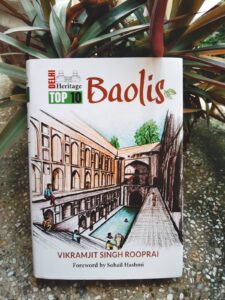Published by Niyogi Books Pvt Ltd.

“We are creating newer and newer methods to exhaust our resources…and one of these resources is water…the proposal to use step-wells as aquifers and to divert rainwater run-off into them might be one way of, at least, partially reversing the unending cycle of continuous exploitation of our most precious exhaustible resource-water.”
Researched by Vikramjit Singh Rooprai, a heritage enthusiast and photographer, Niyogi Books’ latest publication ‘Delhi Heritage : Top 10 Baolis’, is a very specific and detailed piece of work, focusing on the utility of the step-wells and their importance in meeting the water requirements during olden days of Delhi. Peeping at Baolis from a heritage lover’s point of view, Rooprai navigates through the folklores, the oral history and the links between the past and present conditions of the Baolis.
Adorned with a short foreword by writer and filmmaker Sohail Hashmi, the volume has a lucid language and introduces the concept of Baolis – their basic structure, function, types – thus making it understandable and interesting to laymen. It has been arranged in an easy-to-read format highlighting the location, the positioning of the Baolis, their links with local history and to the places of worship to which they are attached. Rooprai had to do an exhaustive research spanning over 5 years and visited the Baolis himself, multiple times due to the dearth of information offered by the contemporary histories and travelogues. The prominent and beautiful pictures of the Baolis are testament to his efforts.
In sleek charts, the specific features of each Baoli has been discussed along with a map and mentions of the nearest important structures. The ten Baolis that find place in this volume are the Ridge Baoli, Hazrat Nizam-ud-Din Baoli, Ugrasen ki Baoli, Munirka Baoli, Gandhak ki Baoli, Purana Qila Baoli, Rajon ki Baoli, Loharheri Baoli, Baoli of Arab ki Sarai and Baoli of Dargah Khwaja Kaki. The significant factors like changes in water levels, accessibility to visitors, cleanliness of the Baoli and the surroundings, usage, area and age of the structures have also been thrown light upon.
The author addresses the vital question regarding the revival of Baolis at the very beginning and proceeds to let us know with ample sources, why the revival would be difficult. An interesting paragraph talks about the Baolis as important community sites connected to the temples and dargahs of Old Delhi and the fascinating rituals connected to them. Credibility of oral history, etymology, comparison and differences between different Baolis comprise a considerable portion of the book.
Ridge Baoli falls under the premises of Hindu Rao Hospital in North Delhi and was intended to supply water to the imperial abode. The water of the Nizam-ud-din Baoli is considered holy and miraculous, and the Baoli of Ugrasen has 180 steps, marking a major significance in Indian culture. The Baoli of Munirka is a part of the Lodhi Era Complex and has a striking design. The Gandhak ki Baoli has been named so by people since the water of the step-well is believed to have sulphur in it which can cure various diseases. Rooprai has briefed the story behind rediscovering the Purana Qila Baoli as well. Rajon ki Baoli has been regarded as the most ornate Baoli in Mehrauli, with beautiful stucco medallions to the east of it. Loharheri Baoli appears to be a close replica of the Wazipur Baoli in R.K.Puram, except for the turrets at the end. Special mentions have been made of Baoli of Arab Sarai and Baoli of Khwaja Kaki.
Thus, the author provides ample interesting bits to keep you hooked to the book. It is rather interesting how the direction of the steps and effect of sunlight, along with the importance of the process of sedimentation in case of the functioning of a Baoli has been discussed with the help of simple diagrams by Nupur Bhatnagar. The author also describes how the cenotaphs and the chambers have been important aesthetic elements of these Baolis. The detailed descriptions of the entrances, walls, roof and inscriptions help the reader to have a vivid image.
While the photographs are great to look at, the production of the book also impresses one who admires history, heritage and culture. For someone who is interested in digging up the lesser-known pearls of Indian history is interested in oral history or is passionate about environment and conservation, the smart and slim volume is worth reading up.
A major publisher of illustrated books which includes translated, fiction, and non-fiction, Niyogi books with the tagline, ‘Fine publishing within reach’ established itself in 2005. In a span of 17 years, the publishing house has over 500 books on its list. Their subject matter is highly varied, including art, photography, culture, textiles, heritage and so on. Additionally, Niyogi’s list of authors and translators is beyond prestigious. Its prices are affordable and readership massive. For their exceptional work, they have received a number of national and international awards including one by the Federation of Indian Publishers and the Academics’ Choice Awards.
To know more about the books they publish and the work they do, visit their website.